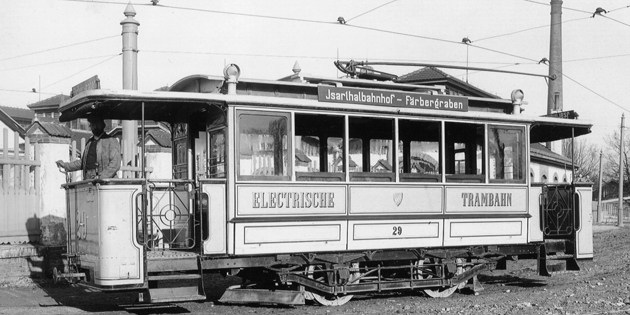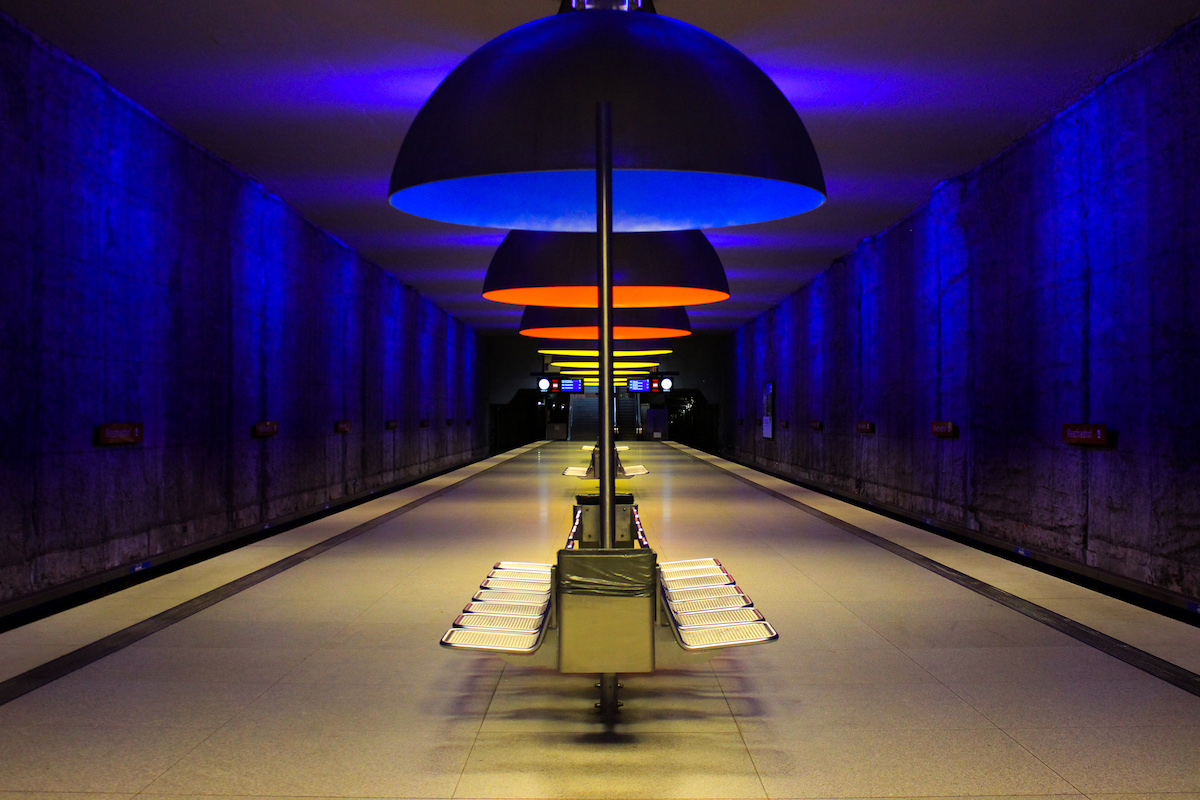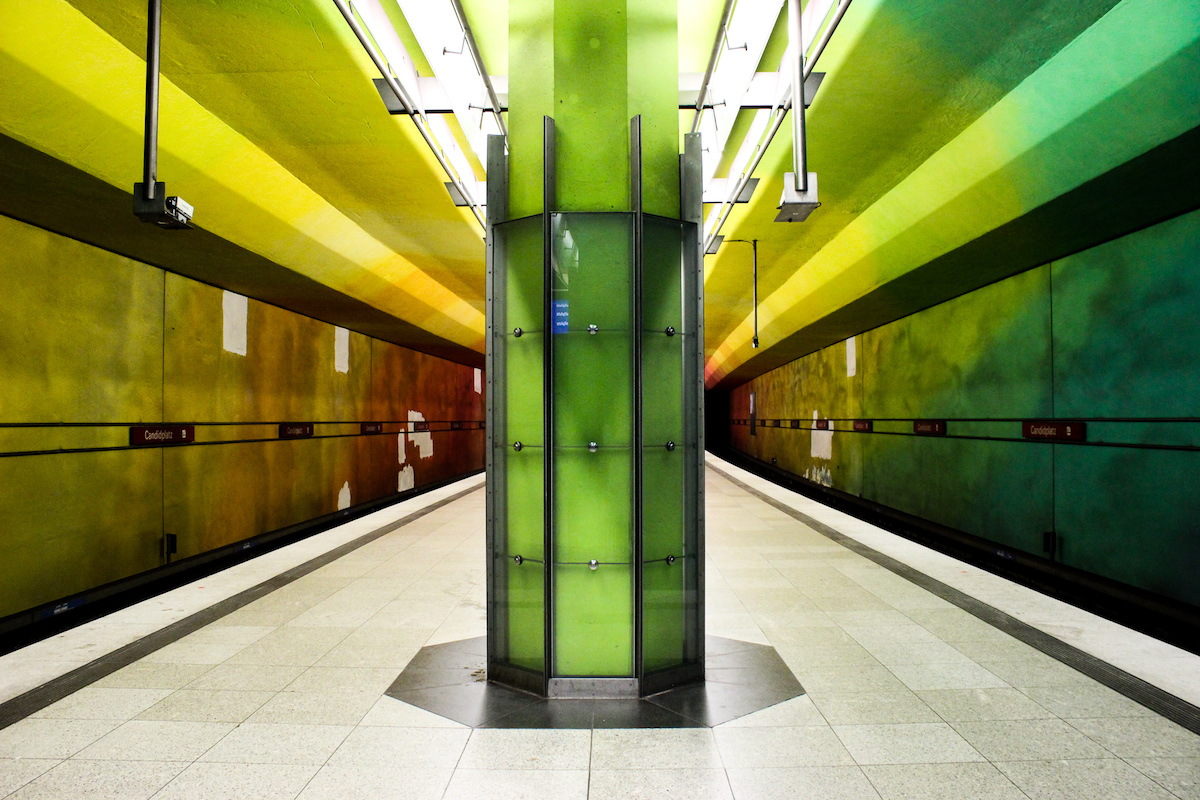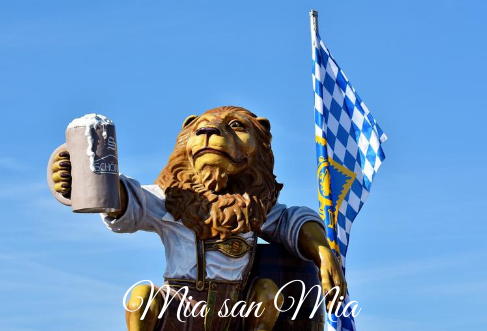June 1861 – Munich had around 150,000 inhabitants – saw the birth of local public transport under private management . For the first time in Munich, the haulage contractor Michael Zechmeister starts regular service with a timetable on a fixed route . It started with a dime wagon pulled by his horses and ran between the central station, Marienplatz and Mariahilf Church. Due to a lack of demand, Zechmeister capitulated in 1882.
AHA! Cool!
MTAG - Munich tram company
In October 1876, a horse-drawn tram on rails also went into operation for the first time. Three years later, in the summer of 1882, the horse-drawn tram became Bavarian . Operation is transferred to the newly founded Münchner Trambahn-Aktiengesellschaft (MTAG). The city of Munich has committed it to an extensive expansion program .

Horse tram
1894 - Conversion to electric traction
In 1894 the magistrate decided to convert all tram lines to electric traction . The following year, the first route is converted to catenary operation on a trial basis. Over the next five years , 1,142 employees will transport more than 40 million passengers with 281 electric railcars and 312 sidecars on almost 58 km of track .
By the way, in December of the same year, the German company "Siemens & Halske" started the construction of the Budapest underground. The track is designed as a " under paved track" ; it is no more than 3 m deep and was inaugurated in 1896 on the occasion of the 1000th anniversary of the state.
Apart from the insignificant beginnings of Ludwig Petuel's first bus company in Munich, founded around the turn of the century, the heyday of the bus only began in 1925 . In 1939 there are already nine lines with 60 vehicles. For better classification, the number of inhabitants of Munich had meanwhile risen to at least 829,000 .

first electric tram in Munich
The two world wars had a lasting impact on the operation and infrastructure of the Munich tramway. At the time, the conscription of every second employee at the beginning of World War I made massive restrictions on the tram network, which consisted of 25 tram lines, necessary. Because of the shortage of staff , women were hired as conductors for the first time in 1915 .
Unbelievable
1930 - Plan of the National Socialists
In the 1930s, the Nazis planned to ban trams underground . Hitler was a great supporter of the car and a great opponent of the above-ground tram . After the war , former tram lines are temporarily used by buses. The network of bus feeder lines in the suburbs is growing.
In 1950 the tram received a major order from the city of Munich and thus the first modern high-capacity train . At this point in time, the population of Munich was already around one million again! In the so-called supplementary area, whose 12 communities are almost as urbanized as some of the outskirts of Munich itself, the growth rates in 1950/56 were around 15% .
Munich was the fastest growing city in western Germany. In addition, Munich had the highest car density . The streets were increasingly congested, and everyone was talking about the lack of traffic . The first tunnel concepts had already existed at the beginning of the 20th century with the idea of a planned north-south tunnel route that could direct long-distance traffic into the inner city and perhaps through it.
Due to the outbreak of the Second World War, all work and planning on the Munich S-Bahn network was put on hold in the years that followed. After the end of the war, the part of the tunnel that had already been built was temporarily used by the people of Munich to grow mushrooms .
1965 - A new transport age on the way to becoming a cosmopolitan city...
In 1965, the federal government, the Free State of Bavaria, the state capital of Munich and the then Deutsche Bundesbahn signed a contract for the construction of the Munich S-Bahn. The Olympic award in April 1966 in Rome by the International Olympic Committee to host the 1972 Summer Olympics in Munich accelerated the first overall transport plan. The planned S-Bahn and U-Bahn had to be operational within six years . Almost unbelievable!
February 1965 begins the construction of the subway at Nordfriedhof and in October 1971 the 12 km long subway line U6 from Kieferngarten to Goetheplatz opens. The city chose the number 6 because the new subway system replaced tram line 6 on Leopoldstrasse.
In May 1972, just in time for the start of the Olympic Games in August 1972, the 4km long section of the U3 from the Münchner Freiheit to the Olympiazentrum was opened. This part of the "Olympic Line" is now a listed building.
In the 1980s, the subway expanded in all directions , from the 1990s to the outskirts of the city. When a new tunnel was dug in Trudering in 1994, groundwater seeped in. The rock above the tunnel sags. A huge crater opens up on the road , tearing a bus down. Three people are killed and 36 others are injured, some seriously. It is the worst accident in the history of subway construction.
Revolutionary - Iron Mole
Some of the revolutionary techniques that attracted 40,000 interested parties from 50 countries to the construction sites were developed and successfully tested in Munich. The highlight: With the help of an " iron mole" from America, most of the section could be excavated using " shield tunneling ", i.e. underground, and the construction time originally estimated at twelve years was reduced by almost half.
Munich also broke new ground by not ramming the vertical profile beams into the ground with a great deal of noise, but placing them in pre-drilled holes so that they can be used again and again . At the time, an expert described the tunneling under the town hall, which resulted in a multi-storey station and crossing structure , as “probably unique in the world”.
For the first time in Europe , all trains in Munich were radio- linked to a central control room. They were developed by an aviation company, had air suspension and could be driven fully automatically . The electronics of the interlockings – computers did not yet exist – calculated meaningful instructions for driving, braking or stopping .
The history of the S-Bahn and U-Bahn is closely intertwined, not only because stations were built at the same time at Marienplatz , but also because the city itself was considering an east-west route. In 1963, the city then came to an agreement with the Federal Railways , gave them the route for the main S-Bahn line and ended what was then known as the "route dispute" .
Opening subway - 1972
At the end of April 1972, Munich celebrated the opening of the subway , and a month later the S-Bahn was running according to the timetable. In just a few years, Munich got a complete underground local transport system for the 1972 Olympic Games. The construction of the so-called “ main route ” (11km long east-west connection from Ostbahnhof to Pasing) also took less than six years.
The S-Bahn network was originally 360km long and served 136 stations. Gradually it grew to today's 444 kilometers with 150 stations . Today, the S-Bahn circles the earth one and a half times with around 1,100 trips a day and covers almost 21 million kilometers a year .
"Trivia" ...
Oh yes, "trivia" - on the evening of November 3, 2008, the first and so far only child was born in a Munich S-Bahn train at Munich-Pasing station. As a birthday present, Deutsche Bahn gave it a lifelong free ride on all Munich S-Bahn trains.

Marienplatz underground station
Performance is often underestimated...
Today the subway network is 95km long. 80,000 "routes" are set by the interlockings every day to bring the 439 million passengers to their destination station. 2022 signals control the subway operations. A train has a total mileage of around 110,000 km per year. Munich subways can travel at speeds of up to 80 km/h , the average speed is 34.8 km/h.
Today, public transport in Munich is based on four pillars :
Subway, S-Bahn, tram and bus.
What's exciting to see
Accessible underground art
Passengers take escalators or elevators deep underground. To counteract the feeling of narrowness and darkness beneath the earth's surface, architects and designers create subway stations that are impressive to behold. Even at night and underground and when it rains (how convenient) Munich is charming and worth a visit.
Functional, safe and user-friendly design
Basically, from an expert's point of view, when designing a subway station, a number of factors need to be considered to ensure that the station is functional , safe and user-friendly .
- Accessibility : A U-Bahn station should be accessible to everyone, including people with disabilities - in Germany alone there are around 11 million people with mobility or activity limitations. This includes access to elevators, escalators and platforms as well as the design of entrances and exits.
- Safety: Passenger safety is of the utmost importance. The station should be designed to prevent crime, accidents and other dangers. This includes lighting, security cameras, emergency phones, and other security devices.
- Light: Adequate lighting is crucial to provide a sense of security. A well-lit environment helps users better understand their surroundings and prevents feelings of loneliness.
- Capacity: The station must have sufficient capacity to handle a large number of passengers. This includes the design of platforms, corridors, stairs and elevators to ensure smooth movement of passengers.
- Comfort: A subway station should be designed to make passengers feel comfortable and safe. This includes the design of seating, waiting areas, toilets, kiosks and other facilities that can increase passenger comfort.
- Accessibility: The station should be designed to be easy to understand and user-friendly. This includes the design of wayfinding, signage, maps and other visual aids that can facilitate navigation around the station.
- Aesthetics: The design of the station should also be aesthetically pleasing and create a comfortable environment. This can be achieved through the use of colors, materials, artwork, and other decorative elements.
- Sustainability: When designing a subway station, sustainability should also be considered. This includes using energy efficient lighting and other equipment, and implementing waste management and recycling programs.
Attractively designed stops in Munich
Some examples:

Subway Station_Olympia Shopping Mall

U_Bahn stop_Westfriedhof

Subway station_Klinikum Grosshadern
- Ingo Maurer was also responsible for the light at the Münchner Freiheit stop, which has been presented in yellow and blue since 2009.
- The Moosach underground station is all about flower power: large-format flowers by the Munich artist Martin Fengel adorn the walls.
- Königsplatz : Copies of well-known works of art from the surrounding museums adorn the walls of this station.
- The St. Quirin-Platz station is covered with a huge glass dome.
- Colorful geometric squares, reminiscent of the former test image on the television, await the passengers at the Georg-Brauchle-Ring . The artist Franz Ackermann hung a total of 400 metal plates, each weighing 135 kilograms.
- The St. Quirin-Platz station is covered with a huge glass dome.
- The Candidplatz underground station is named after its designer: the artist Peter Candid reached deep into the paint pots here. The result: a rainbow stop.

Subway station_St. Quirin place

Subway station Candidplatz in rainbow color
The artistic designs make the subway stations in Munich
to unique, inspiring spaces
and contribute to the city's reputation as a metropolis of art and culture.
